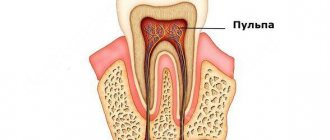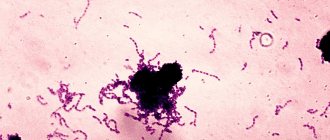Spending a long time in the cold or severe hypothermia can lead to inflammation of the dental nerve. The dental nerve can also become inflamed in hot weather, for example, if the window in your car is open. Inflammation of the dental nerve is an unpleasant disease; it may be indicated by symptoms such as the appearance of painful pulsation, constant aching pain in the tooth. If these symptoms are present, it means you have the nerve of the tooth is chilled. The very first thing to do is to understand which tooth is damaged.
Healthy teeth do not react in any way to temperature changes; usually we do not notice it at all. But if any pathological processes occur inside the dental shell, then from a long walk in the cold you may feel severe toothache. The most correct decision in this situation is to seek help from a dentist.
What to do if the nerve in the tooth has caught a cold - symptoms, treatment and prevention
After a long stay in the cold, your tooth may ache. In this case, aching pain with twitching usually occurs - this is a direct sign of a cold nerve. If your teeth are in perfect order, they should not give any reaction to temperature changes. But if there is a pathological process, including a hidden one, it can worsen as a result of hypothermia. Further in this article we will talk about what to do if the nerve of the tooth has caught a cold, and how to quickly get rid of toothache and prevent the development of complications.
Opening an abscess on the gum
The abscess is always opened. This reduces the risk of spontaneous opening, which can cause complications. The flux is opened under local anesthesia. If the patient has panic or other indications, the doctor may choose a different method of anesthesia.
A small incision is made on the anesthetized gum in the area of the gumboil, no more than 2 cm in length. After the dissection, the doctor completely cleans and sterilizes the purulent cavity and treats it with antiseptics. A crust should not be allowed to form in the area of the incision, as it will interfere with the outflow of ichor and purulent contents. To do this, a drainage is inserted into the incision. After the cavity is cleared of pus, you can begin general treatment, the purpose of which is to eliminate the causes that caused periostitis.
Where is the nerve located in the tooth?
The visible part of the tooth is called the crown - it is covered on top by a layer of enamel, under which there is dentin. Below it is a central part filled with pulp. We are talking about a neurovascular bundle located in the cavity and passing into the internal structures of the root system. The pulp is penetrated by many nerves and vessels. In this case, the number of nerves corresponds to the number of roots. The largest nerves are directly connected to the root processes, while the small ones are concentrated in the pulp chamber.
The photo shows the structure of the tooth
When acute painful sensations occur in a tooth, most often this indicates the development of a pathological process in the pulp. A natural consequence of nerve inflammation is pathologies such as pulpitis and periodontitis. In the initial stages of the disease, there is always a chance to save the pulp and the tooth itself. If the pathology is too advanced, depulpation (pulp extraction) or even tooth extraction may be required.
Types of inflammatory diseases
There are two categories of diseases that provoke the development of such a process. These include:
- Diseases affecting soft tissues. They are caused by injury to the gums. It occurs due to mechanical pressure and chemical burns.
- Diseases of the mucous membrane. Most often they are provoked by infection or fungi. These include diseases such as stomatitis, gingivitis, periostitis, and periodontitis.
Only a doctor can tell you the exact reason. A visual examination of the oral cavity is carried out, and tests for various pathogens will also be required.
What is the true cause of nerve inflammation
Various factors lead to inflammation of the neurovascular bundle. Among the most common causes of the development of a pathological condition, experts in the field of endodontics identify the following phenomena:
- advanced untreated caries, turning into pulpitis,
- injuries, chips, fractures,
- poor quality treatment leading to relapse of the disease,
- filling using low-quality composites and medications,
- medical errors made during the treatment of the crown before prosthetics,
- other dental diseases accompanied by infection of dental tissues.
Pulpitis can cause inflammation.
As for whether it is possible to catch a tooth nerve, too much exposure to the cold can indeed provoke acute symptoms of inflammation. In such cases, they usually say that the tooth is blown or caught a cold. But in fact, an acute reaction is only a consequence of already existing problems, and the cold is only a kind of trigger.
How to recognize the problem - characteristic symptoms
With inflammatory processes in the pulp, symptoms inevitably arise, and they are very intense, so it is quite difficult not to notice them. The most common signs of a problem include the following:
- aching, increasing pain, which can be localized both in the tooth itself and in the jawbone area, radiating to the ear or eye,
- often the pain becomes shooting in nature,
- increased sensitivity of the enamel appears, acute reactions occur to cold, hot, spicy and sour, any mechanical irritants,
- Sensitivity may also extend to the eye and forehead area,
- discomfort appears while eating, talking, or when trying to smile.
One of the symptoms is aching, increasing pain in the tooth or in the entire jaw.
The root cause of the problem is always the pathological phenomena already present in the tooth. When pathogenic microorganisms penetrate the pulp, acute pain of a pulsating nature occurs. It becomes especially strong at night. In such a situation, a sudden change in temperature or prolonged exposure to the cold provokes acute symptoms. When the nerve is inflamed, pulpitis is usually diagnosed, but if the inflammation extends beyond the pulp, periostitis (flux) or periodontitis may develop, including the formation of purulent neoplasms.
What to do if your nerve gets cold
Regarding what to do if there are obvious signs of nerve inflammation and how to quickly relieve severe pain, experts suggest first carrying out antibacterial treatment of oral tissues in order to prevent the further spread of the pathological process. This can be done by rinsing your mouth with Chlorhexidine or, say, a soda-saline solution.
Gargling with a soda-salt solution will help relieve acute pain.
Next, it is imperative to relieve the pain, but in no case should you apply heat to the cheek from the side of the causative element - this will only intensify the acute symptoms and provoke an even greater spread of inflammation. Read on to find out how best to act in such a situation.
Emergency help
If the tooth hurts very badly, before visiting the doctor you need to at least muffle the symptom a little, and in this case you can take a painkiller tablet: “Ketanov” or, for example, “Nalgesin Forte”. For urgent help, you can resort to external agents with an anesthetic effect. These include the drugs “Lidocaine”, “Kamistad gel”.
Drug therapy
If signs of inflammation appear, the first thing to do is immediately go to the doctor. After a visual examination and assessment of the current condition of the causative tooth, the doctor will definitely send you for an x-ray. Having all the necessary data in hand, the specialist will choose a further vector of treatment: conservative therapy, depulpation or even complete removal.
If the doctor chooses a conservative direction, in this case it will be necessary to open the crown, treat the pulp and administer an antibiotic. After a few days, the acute inflammation should subside - then the patient will be sent for a repeat X-ray. If everything is normal, the doctor will place a permanent filling and prescribe appropriate medications. In such situations, painkillers, antiseptic rinses, and special medicinal pastes are usually prescribed. If the case is advanced, the drug "Amoxiclav" or "Ciprofloxacin"1 may be prescribed.
The photo shows the canal treatment scheme
Surgical intervention is resorted to in the last stages of the pathological process - with the development of pulpitis and periodontitis. To ensure that all foci of inflammation are eliminated, the tooth must be depulped, the canals treated and filled. In this case, a tooth without a nerve, in theory, can no longer hurt, although in practice there are relapses of the symptom after removal of the pulp. This happens when the root canals are treated insufficiently, in which pockets of inflammation remain, if fragments of pulp remain in the canals, or if the pathological process has led to the formation of neoplasms in the root area. In all these cases, urgent assistance from a specialist is required.
What does traditional medicine offer?
If acute symptoms develop, you should definitely visit the dentist, and it is better to do this as soon as possible. Only a doctor can choose an adequate treatment that will be effective and at the same time safe. As a maintenance therapy, the use of traditional medicine recipes is allowed, but only after their agreement with a specialist. Below are popular recipes:
- alcohol tincture with birch buds: to prepare the product, you need to take 25 g of raw materials and pour a glass of alcohol into it. Mix the ingredients thoroughly and leave in a cool, dark place for a week and a half. After this time, the solution will be ready for use - just dip a cotton swab into it and then apply it to the affected area,
Birch bud tincture is used in folk medicine - chicory: approximately one tablespoon of chicory should be diluted in a glass of boiling water, then left for several hours to allow the product to infuse. You can then rinse your mouth with it as needed.
- sage: dilute a few spoons in boiling water (one glass). After this, the broth should be left until it cools completely. The product can be used at intervals of 30 minutes until the condition normalizes,
- decoction of willow bark: pour 5 teaspoons of crushed willow root into a glass and pour hot boiled water. Afterwards, cool and use as intended, after diluting a little with warm water.
“Once in the winter I caught a toothache, and such an unpleasant nagging pain appeared. By evening it got worse. I remembered my grandmother’s old recipe - add a piece of lard. You won't believe it, but it worked! The next day, of course, I run to the dentist. It turned out to be caries, which is why the tooth gave such a reaction to the cold. But the lard saved me, I don’t know how, but it’s a fact.”
Olchik, from correspondence on the forum www.32top.ru
Remember: traditional medicine will help only in symptomatic therapy and only as support for the main treatment. With their help, it is impossible to eradicate the disease, and even if all the symptoms disappear, this will not eliminate the need to visit the dentist.
Medicines
Ledocaine, Ketanov, Indomethacin - first aid against pain from an inflamed tooth nerve.
You can name several of the most popular medications that are used as an anesthetic for inflammation of the dental nerve:
- Ledocaine is a very well-known local anesthetic used in various fields of medicine. To anesthetize the inflamed nerve, apply the drug (gel) to a cotton swab and apply to the affected area for fifteen minutes. If you bought the drug in the form of a spray, then spray about 20 mg on the aching tooth, repeat the procedure every hour and a half, the maximum dose per day is 20 procedures. Before starting treatment with Ledocaine, read the instructions, especially the “Contraindications” section.
- Ketanov , usually widely used in tablet form. Do not exceed the daily dose of 5 pcs. and do not take the drug for more than one week. The greatest effect is when taken before meals. Much superior to the usual Analgin and Indomethacin. The action lasts up to eight hours. There are a number of contraindications.
- Indomethacin is a good pain reliever, taken three times a day; if the effect is not sufficiently pronounced, the dose can be increased to 50 mg. It is better to use after meals and wash down with milk. With prolonged use, exacerbations of chronic diseases are possible. It is advisable to read the instructions carefully before use.
All these drugs will help relieve attacks of severe pain, but do not forget that only a visit to the dental office can relieve you of the disease itself and help avoid possible complications.
Moscow metro station Zvezdnaya, Danube Avenue, 23
What to do is strictly contraindicated
We have figured out how and with what to treat an inflamed nerve, and now let’s move on to the question of what absolutely cannot be done if the neurovascular bundle is damaged. With this clinical picture, the pain can be very severe, and not all painkillers and anti-inflammatory solutions can relieve the disturbing symptom. Relying on self-medication in such a situation is strictly contraindicated. Even if you manage to relieve the discomfort, the pathology will continue to spread and destroy the internal structures of the tooth, which will ultimately lead to the need for its removal.
Under no circumstances should you apply a heating pad to an inflamed nerve.
You cannot self-prescribe antibiotics or any other medications, or use traditional medicine without first talking to your doctor. Also, you should not apply a heating pad to the sore spot - heat will only intensify the pain and provoke further spread of inflammatory processes.
Physiotherapy
Physiotherapeutic methods are used as additional ones. They allow you to quickly cope with the infection and stop the inflammatory process. The following methods can achieve good results:
- Fluctuarization. The inflamed tissues are exposed to low voltage current.
- Electrophoresis with lidase. Electrical current is applied to the tissue, allowing the drug to be effectively distributed.
- Ultrahigh frequency therapy. The method is based on the influence of an electromagnetic field.
- Ultrasound therapy. The effect of ultrasound on infected tissues accelerates their regeneration.
- Laser therapy. Damaged tooth tissue is treated with a laser beam.
Preventive measures
Most often, the true cause of the problem is advanced caries, when the lesion penetrates deeper into the internal structures of the tooth and captures the nerve. As a result, any mechanical or temperature effect provokes severe pain, and sometimes can even aggravate the situation with complications. If the tooth is completely healthy, it is almost impossible to develop hypothermia due to prolonged exposure to low temperatures.
Preventative dental examinations will help avoid problems.
To protect yourself from problems with dental nerves, you need to treat any dental diseases in a timely manner. Better yet, do everything possible to prevent their development. In this regard, experts strongly recommend adhering to basic hygiene rules: brushing your teeth at least twice a day, using mouth rinses and visiting the dentist at least twice a year - for prevention and prophylaxis. hygiene. Conscientious implementation of these simple rules will help protect against most dental problems, including pulpitis, periostitis and periodontitis.
- Zoryan E.V., Rabinovich S.A., Matveeva E.G. Algorithm for choosing local anesthetic drugs, problems and solutions, 2008.
Rinse
They are used as an additional treatment in order to completely remove pus and ichor from an opened abscess and prevent the infection from spreading to healthy areas. Soda-salt baths and rinsing with antiseptic solutions help make treatment more effective and speed up gum healing. When rinsing, you must adhere to the following rules:
- During the day, do 4-5 gentle rinses or baths. To do this, just take the solution into your mouth and hold it for about 30 seconds.
- During the day, do 4-5 gentle rinses or baths. To do this, just take the solution into your mouth and hold it for about 30 seconds.










